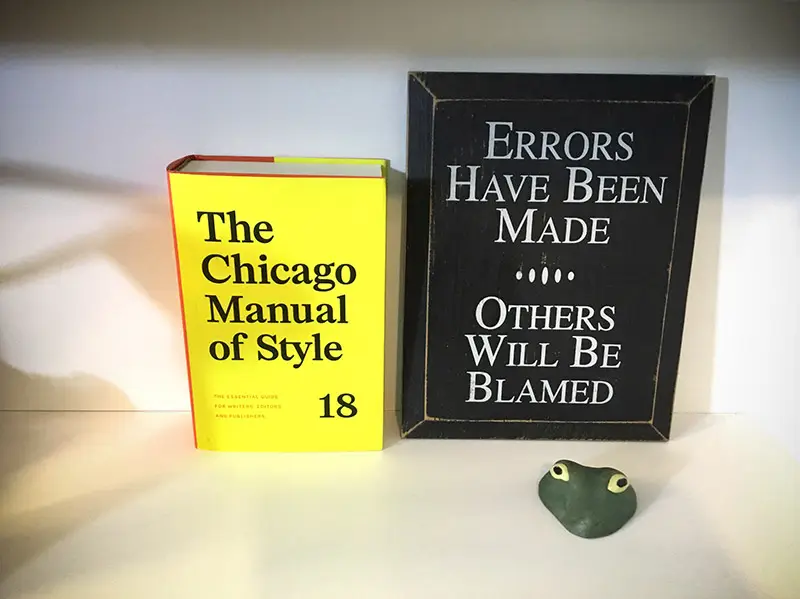After Seven Years, a New Chicago
Guest post by Christian Nelson
Copyeditor, Writer, and Designer
It weighs in at two and one-third pounds. The trim size is approximately six-by-nine inches. It’s about two and one-half inches thick. The dustcover (going against tradition) is yellow. A bright yellow. The actual hard cover (cloth) is a dignified, subdued orange with silver type. And if you count the pages, you will find that there are one thousand one hundred and eighty-one pages (not counting the Preface and the Acknowledgment pages in the front matter). The Index alone comprises twenty-nine pages in very small type.
The title on the dustcover is set in black type. The large, bold, and very black serif typeface spells out the words The Chicago Manual of Style along with the number 18. In smaller, reddish-orange type are the words, The Essential Guide for Writers, Editors, and Publishers.
Published by the University of Chicago Press, the CMOS (The Chicago Manual of Style) refers to itself as “essential” – and that’s exactly what it is. Unfortunately, most writers have never heard of the CMOS. And if they have heard of it, they think it’s a book for editors, not for writers.
If you see yourself as a serious writer, you need this book
When I say that you need this book, you might say, “If I’m going to hire a copyeditor to rid my work of all errors and problems, why would I need a book like that? I’m a writer, not an editor.”
Good point. But if you are a serious writer, this thick and heavy book is a lot more than a desk accessory. Even occasional and casual reading of this book will make your writing better. You want your readers to see you as a real writer – not an amateur. And when your work lands on the desk of an agent or editor, you will want them to see you as a serious writer who not only knows how to write but also understands the craft of writing and even a bit of the business side of things. And those people will recognize the difference between you and the unwashed masses of unprofessional writers. That’s what The Chicago Manual of Style can do for you.
Even though your copyeditor will work hard to find and correct every problem with your writing, the more problems there are in your text, the more likely it is that your copyeditor will miss something. Even the best copyeditors can be overwhelmed. If you are well-versed in the finer points of your craft, your copyeditor will be able to do a better job for you.
Good copyeditors tend to know a lot about the mechanics of copyediting, but they can’t know everything. And most copyeditors know very little about the important things such as manuscript preparation, what should be included in the front matter of a book, publishing contracts, and agreements. Your copyeditor or proofreader probably can’t help you with that.
But Chicago has lots of information on those topics. And what Chicago says on those topics isn’t just regurgitated information copied from other websites. No. What Chicago says is original advice and guidance on those topics – widely considered to be “The Word.”

want to just write and not worry about typos, etc.?
I’ve read and studied the grammar and style books, so you don’t have to. Problems with your writing? I’ll fix them.
The Chicago Manual of Style started as a “style guide” in 1906, and has been in print ever since. Now known as The Chicago Manual of Style or CMOS or just plain Chicago, the book is now in its eighteenth edition, and is considered by almost every professional editor and publishing house as the arbiter of questions related to grammar, the use of numbers, punctuation, ellipses, phrasal adjectives, abbreviations, italics, capitalization, time, subordinate clauses, quotation marks, parentheses, word usage, prepositional idioms, hyphens, dashes, dangling modifiers, and other intimidating-sounding topics.
Additionally, the CMOS answers questions about rights, permissions, and copyright administration – things you need to know about before approaching agents and editors.
Do you really have to know all this stuff?
Maybe you don’t have to actually know everything covered in Chicago, but if you know a lot of what’s in this book, your writing will be more clear and your text will have fewer of the kind of mistakes that make you look like an amateur. And because your writing will be sharper with fewer problems, your copyeditor will be happier and might finish your project a lot faster and maybe for less money without being bogged down by so many problems.
And wouldn’t it be great if some day your copyeditor marks something as an error and wants to change it, but (because you have studied Chicago), you know that you are in the right? Wouldn’t it be fun to show the copyeditor that the way you wrote it is completely in accordance with the dictates of The Chicago Manual of Style? Of course it would.
Get yours now
Right now is the best time to buy this book. The newest edition was released just a few weeks ago, and there are more pages than ever, some important rethinking of some rules, and discussions of our ever-changing language. Whether you are new to Chicago or have owned a copy for years, now is the time to get the latest and the greatest.
This book is so great that you can learn a huge amount about language and writing even if all you read is the Preface.
Buy direct from the University of Chicago Bookstore, Amazon, or your own favorite bookstore.


